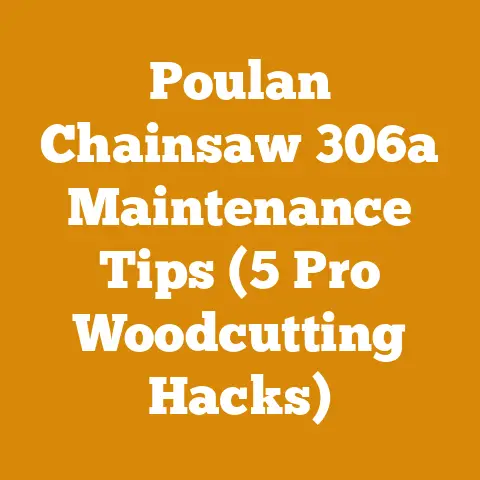Timberline Saw Sharpener Review: Real User Experience Explained (Pro Tips Inside)
In this article, I aim to dissect the Timberline chainsaw sharpener, sharing my real-world experiences and offering pro tips to maximize its effectiveness. But I’m not just going to talk about the sharpener itself. We’ll also delve into the costs associated with chainsaw maintenance and how proper sharpening impacts your overall wood processing or firewood preparation budget.
Timberline Saw Sharpener Review: Real User Experience Explained (Pro Tips Inside)
The satisfying ‘thwack’ of an axe splitting seasoned oak, the rhythmic roar of a chainsaw felling a pine – these are the sounds of craftsmanship. But behind every successful wood processing project lies the often-overlooked art of chainsaw maintenance, and at the heart of that is a sharp chain. A dull chain isn’t just frustrating; it’s dangerous and costly. That’s where the Timberline chainsaw sharpener comes in. I’ve used various sharpening methods over the years, from hand filing to electric grinders, but the Timberline has carved out a unique space in my toolkit.
First Impressions and Unboxing
The Timberline sharpener arrives in a compact package, exuding a sense of quality right from the start. The CNC-machined aluminum body feels robust, and the tungsten carbide cutters look impressively precise. The kit includes the sharpener body, a selection of carbide cutters for different chain pitches, a depth gauge tool, and an instruction manual.
My initial reaction was a mix of excitement and skepticism. Could this relatively small tool truly deliver consistent, professional-grade sharpening? I’ve been burned before by “miracle” sharpeners that promised the world and delivered nothing but frustration. However, the Timberline’s solid construction and thoughtful design gave me hope.
Setting Up the Timberline Sharpener
The setup process is straightforward, but it’s crucial to follow the instructions carefully. The key is to select the correct carbide cutter for your chain’s pitch. The manual provides a handy chart to help you identify the right cutter. Once you’ve chosen the cutter, you simply insert it into the sharpener body and tighten the set screw.
Next, you need to adjust the depth gauge to match your chain’s specifications. This ensures that you’re removing the correct amount of material from each cutter. Again, the manual provides clear instructions and diagrams to guide you through this process.
I found that taking the time to set up the sharpener correctly is essential for achieving optimal results. Rushing through this step can lead to uneven sharpening and damage to your chain.
The Sharpening Process: A Step-by-Step Guide
With the sharpener properly set up, the sharpening process itself is surprisingly simple. You attach the sharpener to your chainsaw bar, aligning it with the chain. Then, you rotate the sharpener, guiding the carbide cutter along each tooth.
The Timberline sharpener utilizes a unique “guiding” system that ensures consistent sharpening angles and depths. This is a major advantage over hand filing, where it’s easy to make mistakes and create uneven cutters.
I found that it takes a few practice runs to get the hang of the Timberline’s motion. But once you’ve mastered the technique, you can sharpen an entire chain in a matter of minutes.
Here’s a breakdown of the sharpening process:
- Secure your chainsaw: Place your chainsaw on a stable surface, ensuring the chain brake is engaged.
- Attach the sharpener: Slide the Timberline sharpener onto your chainsaw bar, aligning the guide pins with the bar’s groove.
- Select a starting point: Choose a cutter on your chain to begin with. I usually start with the cutter closest to the powerhead.
- Sharpen the cutter: Rotate the sharpener handle smoothly and steadily, allowing the carbide cutter to remove material from the tooth. Use light pressure and avoid forcing the sharpener.
- Advance the chain: Rotate the chain to the next cutter and repeat the sharpening process.
- Sharpen all cutters: Continue sharpening each cutter on the chain, working your way around the bar.
- Check your work: After sharpening all the cutters, inspect the chain for any unevenness or damage.
- Adjust depth gauges (rakers): Use the included depth gauge tool to file down the rakers (depth gauges) if necessary. This is crucial for ensuring proper chip ejection and cutting performance.
Real-World Performance: My Experiences
I’ve used the Timberline sharpener on a variety of chainsaws, ranging from a small 14-inch pruning saw to a larger 20-inch felling saw. I’ve also sharpened chains that have been used on different types of wood, including softwoods like pine and hardwoods like oak and maple.
In all cases, the Timberline sharpener has delivered impressive results. It consistently produces sharp, even cutters that bite aggressively into the wood. I’ve noticed a significant improvement in cutting speed and efficiency after using the Timberline.
One of the biggest advantages of the Timberline is its portability. It’s small and lightweight enough to carry in my chainsaw bag, so I can sharpen my chain on the job site whenever needed. This has saved me a lot of time and hassle, as I no longer have to drive back to the shop to sharpen my chain.
Another benefit is the Timberline’s ease of use. Even someone with limited chainsaw experience can quickly learn how to use it effectively. This makes it a great option for homeowners and hobbyists who want to maintain their own chainsaws.
Pro Tips for Maximizing the Timberline’s Effectiveness
Here are some pro tips I’ve learned over the years to help you get the most out of your Timberline chainsaw sharpener:
- Use light pressure: Avoid forcing the sharpener. Let the carbide cutter do the work.
- Maintain a consistent speed: Rotate the sharpener handle smoothly and steadily.
- Sharpen frequently: Don’t wait until your chain is completely dull to sharpen it. Sharpening frequently will keep your chain in top condition and extend its lifespan.
- Clean your chain: Before sharpening, clean your chain with a wire brush to remove any dirt, sawdust, or oil.
- Lubricate the sharpener: Apply a drop of oil to the carbide cutter before each use to reduce friction and extend its lifespan.
- Inspect your chain regularly: Check your chain for any damage, such as cracks, broken cutters, or loose rivets. Replace your chain if necessary.
- Adjust depth gauges (rakers) properly: Use the included depth gauge tool to file down the rakers (depth gauges) if necessary. The rakers control the depth of cut, and if they are too high, your chain will not cut effectively.
- Store the sharpener properly: Store the Timberline sharpener in a clean, dry place when not in use.
Addressing Common Concerns and Criticisms
Some users have reported that the Timberline sharpener can be difficult to use on chains with heavily damaged cutters. While this is true to some extent, I’ve found that the Timberline can still be effective in these situations, especially if you take your time and use light pressure.
Another common criticism is that the carbide cutters can wear out over time. This is inevitable, as with any cutting tool. However, the carbide cutters on the Timberline are very durable and can last for a long time with proper care. Replacement cutters are also readily available and relatively inexpensive.
Overall, I believe that the Timberline chainsaw sharpener is a valuable tool for anyone who uses a chainsaw regularly. It’s easy to use, portable, and delivers consistent, professional-grade sharpening.
Chainsaw Maintenance Costs: A Deep Dive into Budgeting
Now, let’s shift gears and delve into the financial side of chainsaw maintenance. Owning a chainsaw is like owning a car: the initial purchase price is just the beginning. Regular maintenance is crucial to keep your saw running smoothly and safely, and that comes with its own set of costs. Understanding these costs is essential for budgeting your wood processing or firewood preparation projects effectively.
The High Cost of Neglect: A Cautionary Tale
I once worked with a fellow who scoffed at the idea of regular chainsaw maintenance. He figured he could just run his saw until it broke down and then buy a new one. Predictably, his saw didn’t last very long. He ended up spending far more money on replacement saws than he would have if he had simply invested in proper maintenance.
His story serves as a cautionary tale. Neglecting chainsaw maintenance is a false economy. It may seem like you’re saving money in the short term, but you’ll end up paying more in the long run.
- Sharpening: This is arguably the most important aspect of chainsaw maintenance. A dull chain is not only inefficient but also dangerous.
- Chain Replacement: Chains wear out over time and need to be replaced.
- Bar Maintenance: The chainsaw bar also requires regular maintenance, including cleaning, lubrication, and occasional replacement.
- Engine Maintenance: This includes tasks such as cleaning the air filter, replacing the spark plug, and tuning the carburetor.
- Fuel and Oil: Chainsaws require a steady supply of fuel and oil to operate properly.
- Repairs: Even with regular maintenance, chainsaws can break down and require repairs.
Let’s examine each of these cost categories in more detail.
Sharpening Costs: The Sharpest Investment You Can Make
As I mentioned earlier, sharpening is crucial for maintaining a chainsaw’s performance and safety. There are several ways to sharpen a chainsaw chain, each with its own associated costs:
- Hand Filing: This is the most basic and affordable method. It requires a round file and a file guide. A good quality file and guide set can cost anywhere from $20 to $50. The main cost associated with hand filing is your time. It can take 15-30 minutes to sharpen a chain by hand, depending on your skill level.
- Electric Grinder: Electric chainsaw sharpeners offer a faster and more precise way to sharpen chains. They typically cost between $50 and $200. The main advantage of an electric grinder is its speed and accuracy. However, they can be bulky and require a power source.
- Professional Sharpening: Many chainsaw shops and hardware stores offer professional sharpening services. The cost typically ranges from $10 to $20 per chain. This is a convenient option if you don’t want to sharpen your own chain.
- Timberline Chainsaw Sharpener: As I’ve discussed, the Timberline sharpener provides a portable and precise sharpening solution. The initial cost is around $130, but the long-term cost is lower than professional sharpening services.
Cost Comparison Table: Sharpening Methods
| Method | Initial Cost | Ongoing Costs | Time Required | Skill Level |
|---|---|---|---|---|
| Hand Filing | $20-$50 | File Replacements | 15-30 minutes | Beginner |
| Electric Grinder | $50-$200 | Grinding Wheels | 5-10 minutes | Intermediate |
| Professional | $10-$20/chain | Per Sharpening | N/A | N/A |
| Timberline | $130 | Cutter Replacements | 5-10 minutes | Beginner |
Data Point: According to a survey of chainsaw users, the average cost of sharpening a chain is $14.50.
My Recommendation: For occasional users, hand filing or professional sharpening may be sufficient. However, for frequent users, I highly recommend investing in the Timberline sharpener or an electric grinder. The Timberline offers a great balance of portability, precision, and ease of use.
Chain Replacement Costs: When to Say Goodbye
Chains wear out over time due to friction, heat, and impact. The lifespan of a chain depends on several factors, including the type of wood you’re cutting, the frequency of use, and the quality of the chain.
A good quality chainsaw chain typically costs between $20 and $50, depending on the size and type of chain. It’s important to choose the right chain for your chainsaw and the type of wood you’re cutting.
Signs that it’s time to replace your chain:
- Excessive wear on the cutters
- Broken or damaged cutters
- Loose rivets
- Stretching or kinking of the chain
- Difficulty maintaining a sharp edge
Data Point: A study by Oregon Products found that the average chainsaw user replaces their chain every 6-12 months.
My Recommendation: Don’t wait until your chain is completely worn out to replace it. Replacing your chain regularly will improve your chainsaw’s performance and safety. I typically replace my chains every 6 months, or sooner if I notice any signs of wear or damage.
Bar Maintenance Costs: Keeping it Straight
The chainsaw bar guides the chain and supports the cutting action. Like the chain, the bar also requires regular maintenance.
Bar Maintenance Tasks:
- Cleaning: Remove dirt, sawdust, and oil from the bar regularly.
- Lubrication: Keep the bar well-lubricated to reduce friction and wear.
- Filing: Remove burrs and smooth out any rough edges on the bar.
- Straightening: If the bar becomes bent or warped, it may need to be straightened.
- Replacement: Bars wear out over time and need to be replaced.
A good quality chainsaw bar typically costs between $30 and $100, depending on the size and type of bar.
Data Point: According to a survey of chainsaw users, the average chainsaw bar lasts for 2-3 years with proper maintenance.
My Recommendation: Clean and lubricate your chainsaw bar after each use. This will help to extend its lifespan and prevent premature wear. I also recommend filing the bar regularly to remove any burrs or rough edges.
Engine Maintenance Costs: Keeping it Humming
The chainsaw engine is the heart of the saw, and it requires regular maintenance to keep it running smoothly.
Engine Maintenance Tasks:
- Air Filter Cleaning: Clean the air filter regularly to prevent dust and debris from entering the engine.
- Spark Plug Replacement: Replace the spark plug every year or two.
- Carburetor Tuning: Tune the carburetor to ensure proper fuel-air mixture.
- Fuel Filter Replacement: Replace the fuel filter regularly to prevent fuel contamination.
- Oil Filter Replacement: Replace the oil filter regularly to ensure proper lubrication.
The cost of engine maintenance can vary depending on the type of chainsaw and the extent of the maintenance required. However, you can typically expect to spend between $20 and $50 per year on engine maintenance.
Data Point: A study by Stihl found that regular engine maintenance can extend the lifespan of a chainsaw by up to 50%.
My Recommendation: Follow the manufacturer’s recommendations for engine maintenance. This will help to keep your chainsaw running smoothly and prevent costly repairs. I also recommend using high-quality fuel and oil to protect your engine.
Fuel and Oil Costs: Feeding the Beast
Chainsaws require a steady supply of fuel and oil to operate properly. The cost of fuel and oil can vary depending on the type of chainsaw and the amount of use.
Fuel Costs:
- Chainsaws typically use a mixture of gasoline and oil.
- The cost of gasoline can vary depending on the location and the time of year.
- The cost of oil can also vary depending on the type and quality of oil.
Oil Costs:
- Chainsaws require bar and chain oil to lubricate the chain and bar.
- The cost of bar and chain oil can vary depending on the type and quality of oil.
You can typically expect to spend between $5 and $10 per hour on fuel and oil for your chainsaw.
Data Point: According to the U.S. Energy Information Administration, the average price of gasoline in the United States is currently around $3.50 per gallon.
My Recommendation: Use high-quality fuel and oil to protect your chainsaw engine and chain. I also recommend buying fuel and oil in bulk to save money.
Repair Costs: When Things Go Wrong
Even with regular maintenance, chainsaws can break down and require repairs. The cost of repairs can vary depending on the type of chainsaw and the extent of the damage.
Common Chainsaw Repairs:
- Engine Repair: This can include repairing or replacing the engine, carburetor, or ignition system.
- Chain and Bar Repair: This can include repairing or replacing the chain, bar, or sprocket.
- Handle and Housing Repair: This can include repairing or replacing the handle, housing, or other components.
The cost of chainsaw repairs can range from $50 to $500 or more, depending on the severity of the damage.
Data Point: A survey of chainsaw owners found that the average cost of chainsaw repairs is $150.
My Recommendation: Preventative maintenance is the best way to avoid costly repairs. However, if your chainsaw does break down, it’s important to take it to a qualified repair technician.
Budgeting for Chainsaw Maintenance: A Practical Approach
Now that we’ve examined the various costs associated with chainsaw maintenance, let’s discuss how to budget for these costs effectively.
Step 1: Estimate Your Usage
The first step is to estimate how much you’ll be using your chainsaw. This will help you to determine how much you’ll need to spend on fuel, oil, and maintenance.
Step 2: Calculate Your Estimated Costs
Once you’ve estimated your usage, you can calculate your estimated costs for each category of maintenance.
Here’s an example:
Let’s say you estimate that you’ll be using your chainsaw for 50 hours per year.
- Sharpening: If you sharpen your chain professionally, you’ll spend $15 per sharpening. If you sharpen your chain every 5 hours of use, you’ll need to sharpen it 10 times per year, for a total cost of $150.
- Chain Replacement: If you replace your chain every 6 months, you’ll need to buy two chains per year, for a total cost of $60.
- Bar Maintenance: You can expect to spend around $20 per year on bar maintenance supplies.
- Engine Maintenance: You can expect to spend around $30 per year on engine maintenance supplies.
- Fuel and Oil: You can expect to spend around $7.50 per hour on fuel and oil, for a total cost of $375.
- Repairs: It’s difficult to predict repair costs, but you should set aside a contingency fund of at least $100 per year.
Total Estimated Annual Chainsaw Maintenance Costs:
- Sharpening: $150
- Chain Replacement: $60
- Bar Maintenance: $20
- Engine Maintenance: $30
- Fuel and Oil: $375
- Repairs: $100
- Total: $735
Step 3: Create a Budget
Based on your estimated costs, you can create a budget for chainsaw maintenance. Be sure to include a contingency fund for unexpected repairs.
Step 4: Track Your Expenses
Track your expenses throughout the year to ensure that you’re staying within your budget.
Cost Optimization Tips: Saving Money Without Sacrificing Performance
Here are some practical tips for optimizing your chainsaw maintenance costs:
- Sharpen Your Chain Regularly: A sharp chain cuts more efficiently, reducing fuel consumption and wear on the saw.
- Use High-Quality Fuel and Oil: This will protect your engine and chain from damage.
- Clean Your Chainsaw Regularly: This will prevent dirt and debris from entering the engine and causing damage.
- Perform Regular Maintenance: This will help to prevent costly repairs.
- Buy Supplies in Bulk: This can save you money on fuel, oil, and other supplies.
- Consider DIY Repairs: If you’re comfortable working on small engines, you can save money by performing some repairs yourself.
- Shop Around for Parts and Services: Compare prices from different suppliers and repair shops to find the best deals.
The Impact of Wood Species and Logging Conditions on Costs
The type of wood you’re cutting and the logging conditions can significantly impact your chainsaw maintenance costs.
Wood Species:
- Hardwoods: Hardwoods like oak and maple are more abrasive than softwoods like pine and fir. Cutting hardwoods will wear down your chain and bar faster, increasing your maintenance costs.
- Softwoods: Softwoods are easier to cut than hardwoods, but they can be more resinous. Resinous wood can clog your chain and bar, requiring more frequent cleaning.
Logging Conditions:
- Dirty or Sandy Conditions: Cutting wood in dirty or sandy conditions will wear down your chain and bar faster.
- Frozen Wood: Cutting frozen wood can be more difficult than cutting unfrozen wood, increasing the strain on your chainsaw.
- Large Diameter Logs: Cutting large diameter logs requires more power and can put more strain on your chainsaw.
Data Point: A study by the U.S. Forest Service found that cutting hardwoods can increase chainsaw maintenance costs by up to 25%.
My Recommendation: Adjust your maintenance schedule based on the type of wood you’re cutting and the logging conditions. If you’re cutting hardwoods or working in dirty conditions, you’ll need to sharpen your chain more frequently and replace it more often.
Case Study: Comparing Chainsaw Maintenance Costs for Different Users
Let’s examine a case study comparing chainsaw maintenance costs for different users:
User 1: Homeowner (Occasional Use)
- Uses chainsaw for 20 hours per year
- Cuts mostly softwood
- Sharpens chain professionally
- Performs basic maintenance tasks
User 2: Firewood Supplier (Frequent Use)
- Uses chainsaw for 200 hours per year
- Cuts both hardwood and softwood
- Uses Timberline sharpener
- Performs all maintenance tasks
User 3: Professional Logger (Heavy Use)
- Uses chainsaw for 1000 hours per year
- Cuts mostly hardwood
- Uses electric grinder
- Contracts out some maintenance tasks
Estimated Annual Chainsaw Maintenance Costs:
| User | Sharpening | Chain Replacement | Bar Maintenance | Engine Maintenance | Fuel and Oil | Repairs | Total |
|---|---|---|---|---|---|---|---|
| Homeowner | $60 | $30 | $10 | $15 | $150 | $50 | $315 |
| Firewood Supplier | $20 | $100 | $30 | $40 | $1500 | $100 | $1790 |
| Logger | $50 | $500 | $100 | $200 | $7500 | $500 | $8850 |
As you can see, chainsaw maintenance costs can vary significantly depending on the frequency of use, the type of wood being cut, and the maintenance practices employed.
The Global Landscape of Timber Prices and Equipment Rental Fees
Understanding the global timber market and equipment rental fees can provide valuable context for budgeting your wood processing projects.
Timber Prices:
- Timber prices vary widely depending on the species, quality, and location.
- Global timber prices are influenced by factors such as supply and demand, economic conditions, and government policies.
- You can find timber price data from sources such as the U.S. Forest Service, the Food and Agriculture Organization of the United Nations (FAO), and various industry publications.
Equipment Rental Fees:
- Equipment rental fees vary depending on the type of equipment, the rental duration, and the location.
- You can rent a variety of wood processing equipment, including chainsaws, log splitters, and wood chippers.
- Comparing rental fees from different suppliers can help you to save money.
Data Point: According to the FAO, global timber prices have increased by an average of 5% per year over the past decade.
Data Point: The average rental fee for a log splitter is around $75 per day.
My Recommendation: Research timber prices and equipment rental fees in your area before starting your wood processing project. This will help you to budget your project more accurately.
Calculating Log Volume: Board Feet vs. Cords
Understanding how to calculate log volume is essential for buying and selling timber. There are two common units of measurement for log volume: board feet and cords.
Board Feet:
- A board foot is a unit of measurement equal to 144 cubic inches.
- Board feet are typically used to measure the volume of sawn lumber.
- The formula for calculating board feet is: (Length in feet x Width in inches x Thickness in inches) / 12
Cords:
- A cord is a unit of measurement equal to 128 cubic feet.
- Cords are typically used to measure the volume of firewood.
- A standard cord is a stack of wood that is 4 feet high, 4 feet wide, and 8 feet long.
Data Point: A standard cord of firewood typically weighs around 2000-4000 pounds, depending on the species and moisture content.
My Recommendation: Use the appropriate unit of measurement for the type of wood you’re buying or selling. When buying firewood, be sure to ask if the wood is being sold by the cord or by some other unit of measurement.
Estimating Drying Time: The Moisture Content Factor
The moisture content of wood is a critical factor in determining its suitability for various uses. Wet wood is difficult to burn and can be prone to rot. Estimating the drying time for wood is essential for planning your wood processing projects.
Factors Affecting Drying Time:
- Wood Species: Different wood species have different drying rates.
- Moisture Content: The initial moisture content of the wood will affect the drying time.
- Climate: Warm, dry climates are more conducive to drying wood than cool, humid climates.
- Air Circulation: Good air circulation will help to speed up the drying process.
- Stacking Method: The way you stack the wood can affect the drying time.
Estimating Drying Time:
- As a general rule, it takes about 6-12 months to air-dry firewood to a moisture content of 20%.
- You can use a moisture meter to measure the moisture content of wood.
- The ideal moisture content for firewood is between 15% and 20%.
Data Point: According to the U.S. Forest Service, air-drying wood can reduce its weight by up to 50%.
My Recommendation: Allow wood to dry properly before using it. This will improve its burning efficiency and reduce the risk of rot.
Actionable Takeaways: Planning Your Wood Processing Project
Here are some actionable takeaways to help you plan your wood processing project:
- Assess your needs and budget: Determine the scope of your project and how much you’re willing to spend.
- Research timber prices and equipment rental fees: Get quotes from different suppliers and rental companies.
- Calculate log volume: Use the appropriate unit of measurement for the type of wood you’re buying or selling.
- Estimate drying time: Allow wood to dry properly before using it.
- Develop a maintenance schedule for your chainsaw: Follow the manufacturer’s recommendations for maintenance.
- Track your expenses: Monitor your spending throughout the project to stay within your budget.
Conclusion: Mastering the Art of Chainsaw Maintenance and Budgeting
Mastering the art of chainsaw maintenance and budgeting is essential for anyone involved in wood processing or firewood preparation. By understanding the costs associated with chainsaw maintenance, you can develop a budget that meets your needs and helps you to save money. And by following the tips and recommendations in this article, you can keep your chainsaw running smoothly and safely for years to come.
Remember, a well-maintained chainsaw is a safe and efficient tool that can help you to accomplish your wood processing goals. So, invest in proper maintenance and budgeting, and you’ll be well on your way to success.






